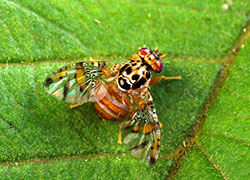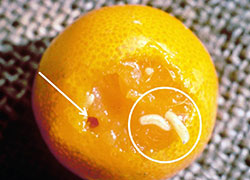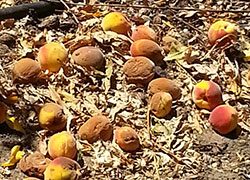
Mediterranean fruit fly information and biosecurity
Mediterranean fruit fly (Ceratitis capitata) is a serious pest in Western Australia and threatens fruit and vegetable industries in eastern Australia
Mediterranean fruit fly is not present in New South Wales and is considered an exotic pest
If found in NSW it must be reported promptly to the Exotic Plant Pest Hotline 1800 084 881
Mediterranean fruit fly
Mediterranean fruit fly (Medfly) is one of the world’s most destructive fruit pests. It’s wide host range and tolerance of cooler climates makes it highly invasive. Medfly has successfully spread and established in many parts of the world.
Host fruits and vegetables are a vital part of the Medfly lifecycle and affected fruit is unsaleable.
Economic impacts for fruit and vegetable producers include reduced yield and quality, increased control costs and lost markets as many countries and regions regulate against Medfly.

Description
An adult Medfly is 3–5 mm long and yellowish brown in colour. The patterned wings have yellowish brown bands extending to the wing tips (Figure 1).
Medfly larvae are creamy-white and about 7–8 mm long (Figure 2).
In comparison, adult Queensland fruit fly is larger (7-8 mm), reddish brown in colour with yellow markings and no visible markings on the wings.

Damage
Fruit and fruiting vegetables are damaged by Medfly egg deposits, larvae feeding and infection by secondary diseases.
Fruit infested with Medfly larvae may show ‘sting’ marks on the surface where females have deposited eggs.
Eggs laid into hard, green, unripened fruit may cause fruit development to become distorted.
Larvae feed inside mature fruit, creating tunnels from the surface to the centre (Figure 2). A water soaked appearance may develop on the surface of the fruit around the entry point.
Fruit rot due to secondary infection often occurs with fruit fly infestations. Infected fruit will drop from the tree or rot on the tree.
Lifecycle
Medfly females deposit eggs under the skin of host fruit that is just beginning to ripen.
Eggs hatch within 2−4 days and larvae tunnel towards the centre of the fruit to feed. Larvae developing inside the fruit can be seen when the fruit is cut open, or when exiting the fruit to pupate.
Larvae emerge from the fruit after 6–11 days of feeding and fall to the ground. Pupation usually occurs under the soil surface with adults emerging after 6−11 days.
Most females are ready to mate 6−8 days after emerging and can lay as many as 22 eggs per day. Adults can live for up to 2 months and usually lay around 300 eggs (though up to 800) in a lifetime.
Host range
Medfly has a very wide host range, infecting the fruit of over 260 different plant species.
Economically important host species include apple, pear, citrus, stonefruits, coffee, mango, persimmon, guava, fruiting vegetables, avocado, berries, cotton, grapes, melons, olive, kiwifruit, various nuts, passionfruit, lychee and banana.
Spread
Locally, adults spread by flying. Flight distance is restricted to less than 1 km.
Long distance spread of Medfly occurs with the transport of larvae in infested fruit.
Distribution
Medfly originates from and is widespread in Africa.
Medfly has spread and established in Europe, the Middle East, Central and South America, Hawaii and Western Australia.
Mediterranean fruit fly in Australia
Australian distribution of Medfly is currently restricted to Western Australia. Following its discovery in Perth in 1895, Medfly has established from Esperance through to Carnarvon, Broome and Derby.
Mediterranean fruit fly quarantine areas
Quarantine boundaries and procedures have been established in Australia to prevent the spread of Medfly from known infested areas in Western Australia to regions and states currently free of Medfly.
Each state or territory has their own regulations in place to prevent the introduction of Medfly or control its spread. For specific import conditions, contact the relevant state authority or go to Australian Interstate Quarantine website.
New South Wales is currently free of Medfly and the introduction of any host fruit or soil from a Medfly infested area is strictly regulated under the Biosecurity Act 2015.
The movement of host fruit or vegetables from an infested area into New South Wales is not permitted unless certified as having met specific import conditions.
Surveillance
Surveillance for Medfly is carried out with the use of traps targeting adults. Traps are positioned and monitored in areas where Medfly are likely to occur such as air and sea ports.
Regular surveillance in New South Wales occurs with Medfly traps located in Sydney and other production areas such as Sunraysia. This surveillance provides both an early detection mechanism and negative trap results to demonstrate New South Wale’s freedom from Medfly for market access.
Management options
Prevention
The distance between New South Wales and current Medfly populations in Western Australia means that New South Wales is relatively safe from the natural spread of Medfly through flight.
Introduction of Medfly to New South Wales is likely to be a result of unintentional movement of larvae in infested host fruits or pupae in soil.
Any movement of host fruit and vegetables from infested areas should be avoided unless certified entry conditions have been met.

Management
A number of management options are currently practised for the control of Medfly, either alone or in combination.
Good farm hygiene is the best defence against all fruit flies. There are three parts to good orchard hygiene (or sanitation):
- removal of non-commercial trees
- removal of unwanted fruit from the orchard
- correct disposal of infested or unwanted fruit.
Any susceptible fruit must be removed and suitably disposed of, or destroyed in situ, on a regular basis during the season. This should be carried out weekly as a minimum.
Any unwanted fruit left on the trees should also be removed and disposed of immediately following final harvest as research has shown that these fruits often become infested. Apples and persimmons in particular are very good overwintering hosts for Medfly as they can hold their shape for over five months.
Options for the destruction of fallen/unwanted fruit (Figure 3) include:
- Soak fruit in a vat of water topped with kerosene, to cut off oxygen transfer for four to five days, then bury.
- Cook or puree the fruit (small quantities only).
- Freeze or store in a coolroom (below 0°C) for at least 20 days.
- Deep burial – must be greater than 1 m deep and covered immediately.
- Mulch the fruit in the rows using a slasher or flail mower. Check while you are doing this to ensure that the fruit is being well mulched.
- Use poultry to clean up fallen fruit and regularly check their effectiveness over the entire orchard.
Actions to minimise risk
Put in place biosecurity best practice actions to prevent entry, establishment and spread of pests and diseases:
- practice “Come clean, Go clean”
- ensure all staff and visitors are instructed in and adhere to your business management hygiene requirements
- monitor your plants regularly
- keep records
Conditions of movement
There are conditions of movement relating to Medfly set out in the Biosecurity Order (Permitted Activities) 2017, under the Biosecurity Act 2015. Part 2 of the Order outlines conditions for importation of host fruit, soil and packaging likely to introduce Medfly into NSW.
Reporting
If you suspect Medfly in New South Wales:
- Call the Exotic Plant Pest Hotline on 1800 084 881
- Email clear photos with a brief explanation and your contact details to biosecurity@dpi.nsw.gov.au

